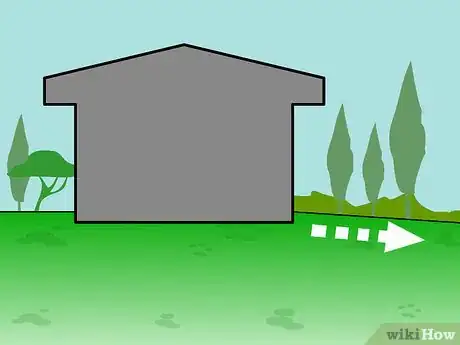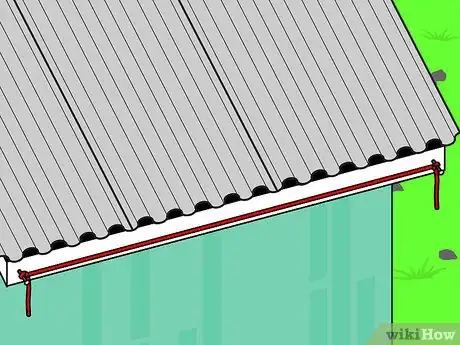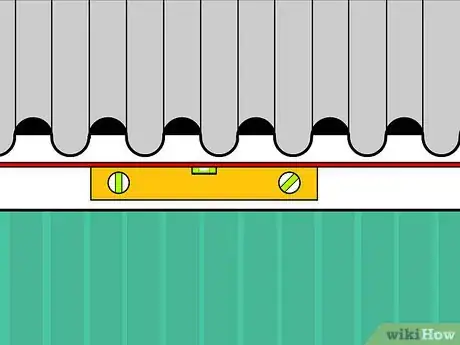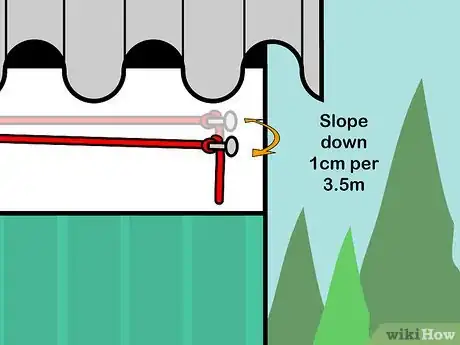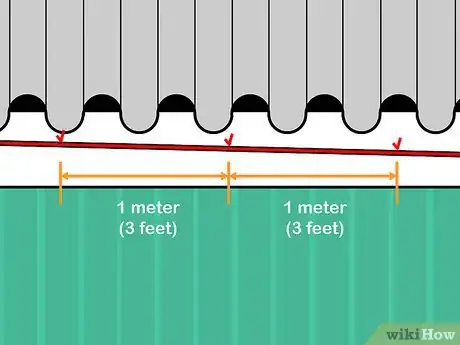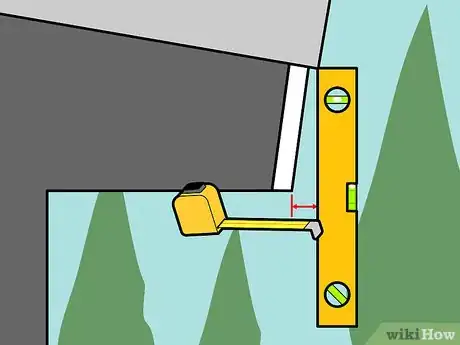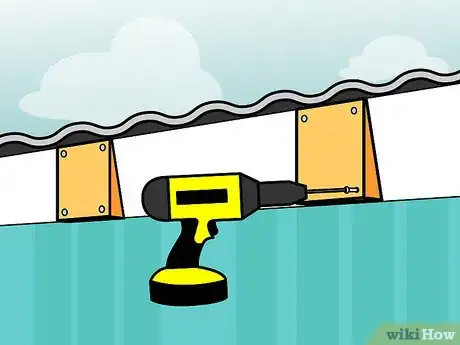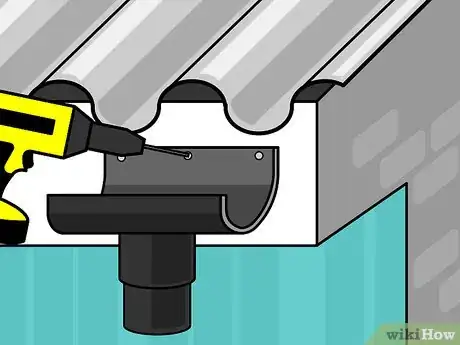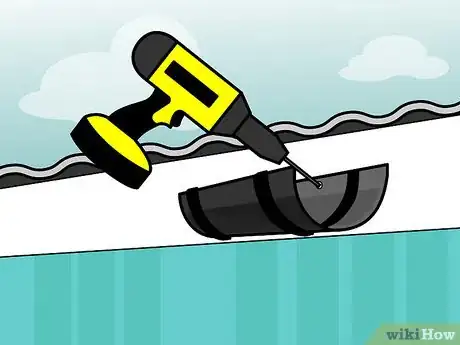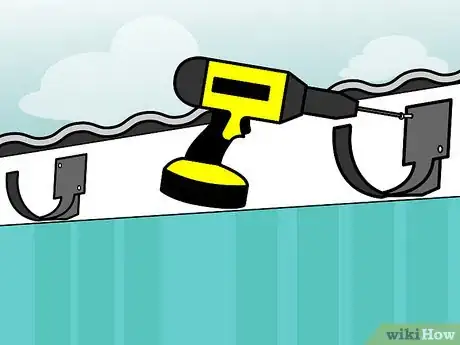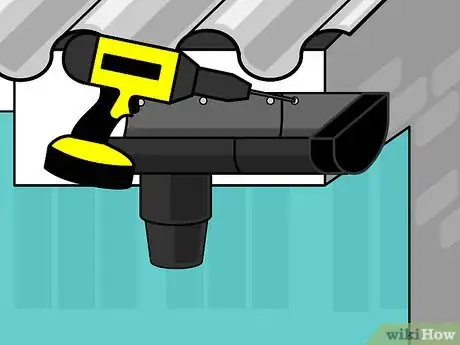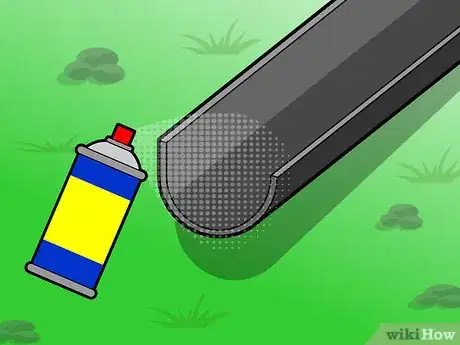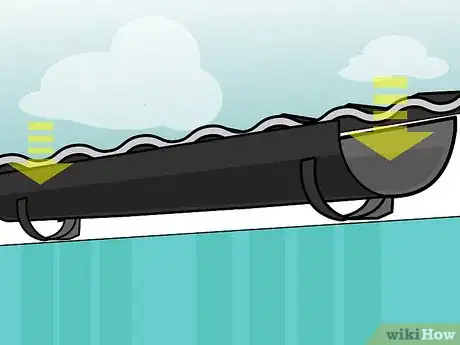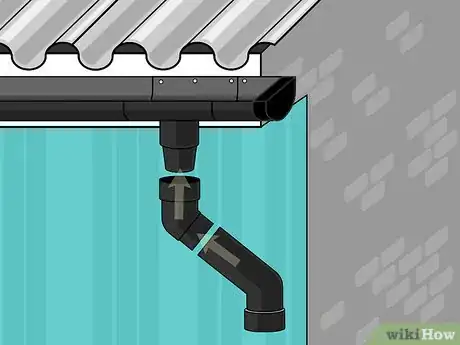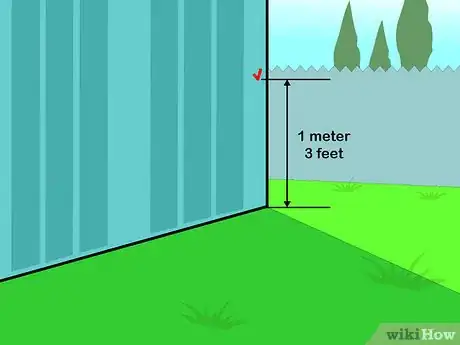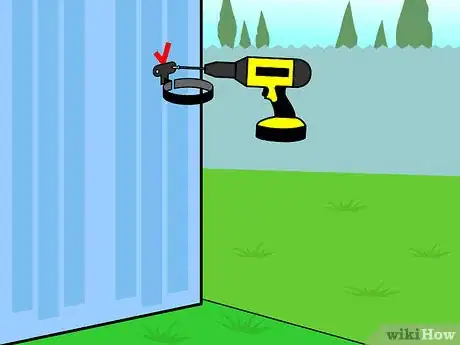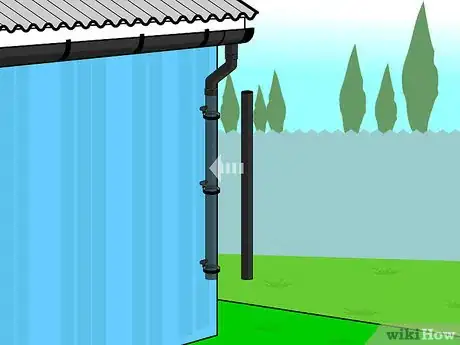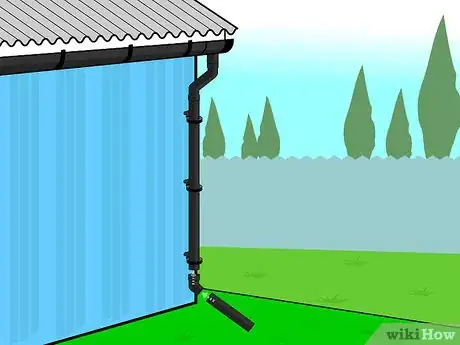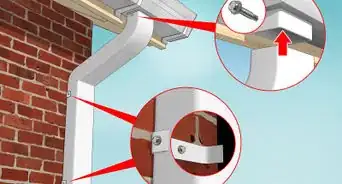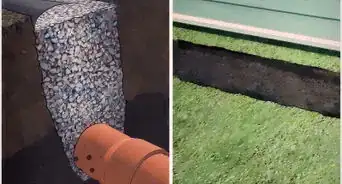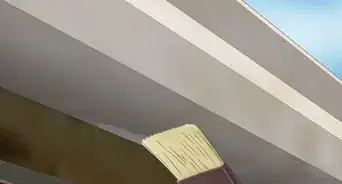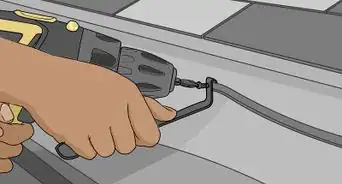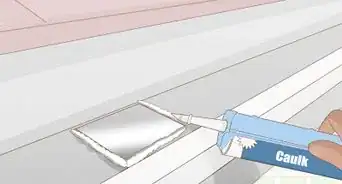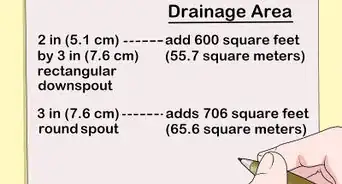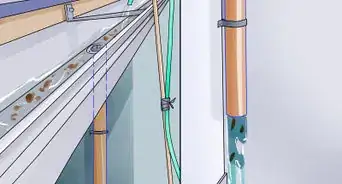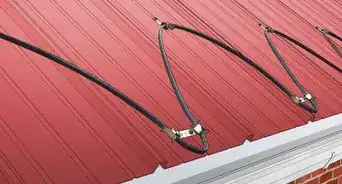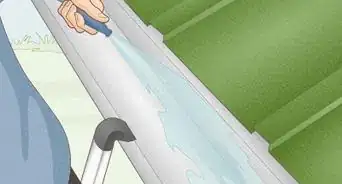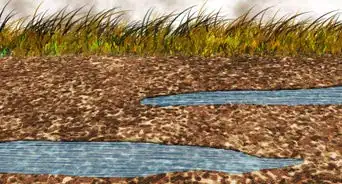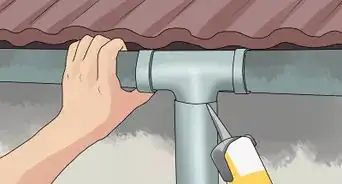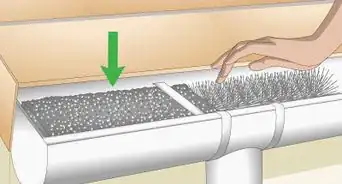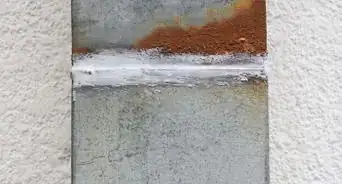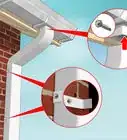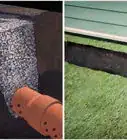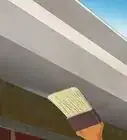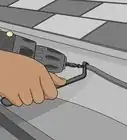This article was co-authored by Jacob Pischer and by wikiHow staff writer, Christopher M. Osborne, PhD. Jacob Pischer is a Home Improvement Specialist and the Owner of Helpful Badger, a home repair service in Portland, OR. With over four years of experience, Jacob specializes in a variety of handyman services including pressure washing, cleaning gutters, repairing drywall, fixing leaky plumbing fixtures, and repairing broken doors. Jacob studied at Madison Area Technical College and has a background in real estate investment.
This article has been viewed 94,949 times.
Attaching a gutter and downspout system to your shed can prevent muddy ground around its base and prevent its walls from rotting prematurely. For structures like garden sheds, easy-to-cut and snap-in-place PVC guttering is an ideal choice. However, if you choose to install gutters made of aluminum or similar metals, the process is very similar. You need to establish the proper slope, attach support brackets, secure the guttering, and add a downspout that will eject the water runoff away from the shed structure.
Steps
Establishing Your Gutter’s Slope and Outlet
-
1Check the slope of the ground your shed sits on. Unless your gutters are draining into an established drain system or a rain barrel, you want your downspout to drain onto ground that slopes away from the shed. Determine the low side of the ground surrounding your shed and plan to install the downspout there.
- If this isn’t possible for some reason, plan to extend the bottom of your downspout away from the shed at least 1 meter (and ideally more than that) to keep water from collecting at the base of your structure.
-
2Tap a nail into each end of your shed’s fascia board. On the side of the roofline where you’ll be installing the gutter, tack two nails into the fascia board that runs below the lip of the roof. Put one nail at each end of that side of the shed, an equal distance below the roof lip (ideally, about 3-5 cm or 1-2 inches if your fascia board is wide enough).[1]Advertisement
-
3Connect the two nails with a taut string. Tie a sturdy string to one of the nails, pull it tight, and tie it off to the other nail. You’ll use this string line to determine how level your shed’s roofline is, and adjust it to establish the slope for your guttering.
-
4Adjust your string line to make it level. Use a bar level (spirit level) to check the level of your string line. In the likely event that it isn’t completely level, remove one of the nails and reposition it up or down until the string is level.
-
5Adjust the string line again to establish your gutter’s downward pitch. Guttering should slope down toward its downspout at least 1 cm per 3.5 m of length (or ¼ inch per 10 feet). Measure the length of your string line from nail to nail. If the distance is less than 3.5 m long (or 10 ft), raise the far side nail by 1 cm or lower the downspout side nail by 1 cm (or ¼ inch).
- Raise/lower the nails by 1.5 cm if the shed is less than 5 m long (or ⅜ inch if less than 15 ft), or by 2 cm if it is less than 7 m long (or ½ inch if less than 20 ft).
- The slope should be 1/8th of a degree from the end that doesn't have the downside to the end that does.[2]
-
6Mark this slope on the fascia board. The guttering will be held in place by support brackets that you’ll screw into the fascia board. To locate where you’ll place these brackets, mark the string's position on the fascia board at each end and at intervals no more than 1 m (roughly 3 ft) apart. Then you can remove the nails and string.
- If you’d like to be able to visualize the entire slope while working, you can remove the string, then use a chalk line tool to unspool its string from nail to nail and snap a line of chalk on the fascia board between them.
-
7Create angled blocks if your fascia board is angled inward or outward. If your fascia board isn’t perpendicular to the ground, hold a bar/spirit level vertically against it. Then pull one end of the level away until the levelling bubble is centered, and measure the gap between the level and fascia board. Transfer these measurements to scraps of lumber and cut them carefully with a saw to recreate the angle.
- If the fascia is only slightly angled, you can use wooden or plastic shims (thin, pre-cut wedges) instead of cutting lumber scraps.
-
8Attach the blocks you just cut to the fascia board. Hold the blocks up to the fascia board and check that you now have a level surface for the brackets. Locate each block where you intend to attach a bracket. Then, drill pilot holes in the blocks and attach them to the fascia with 25 mm (1 inch) wood screws.
- Attaching angled blocks will keep your guttering parallel to the ground, instead of dipping toward or away from the shed. In either of those scenarios, water will pour over the side of the gutter, rendering it much less useful.
Attaching the Drain Outlet and Support Brackets
-
1Install the drain outlet section at the downspout end of the shed. The drain outlet section might screw directly into the fascia board, or it might attach to one or two brackets that you’ll attach to the fascia first. Hold the drain outlet (or its bracket(s)) in position, mark the screw locations on the fascia, and drill pilot holes in those spots. Attach the piece(s) to the fascia with 25 mm (1 inch) screws.
- If your model uses brackets, snap the drain outlet section in place after attaching the brackets.
- The drain outlet section has an opening that points downward toward the ground — this is where you’ll later attach the downspout.
-
2Install one or more joint brackets on larger sheds. If the side of your shed is longer than your longest section of guttering (which often comes in either 2 m or 4 m lengths), you’ll need to join sections of guttering together. At any junction spot, you’ll install a special bracket — a joint bracket — that creates a watertight seal with a rubber gasket.
- If, for instance, your shed is 5 m long and your guttering sections are 4 m long, you can install a joint bracket near the halfway point and later cut two sections of guttering to fit from there to the end sections of the gutter.
- Mark the screw holes, pre-drill the fascia, and attach the bracket(s) with 25 mm (1 inch) screws.
- Joint brackets will come with your gutter kit or be found with the other guttering pieces for sale at your hardware store.
-
3Attach support brackets at the spots you marked earlier on the fascia. Remember, the U-shaped support brackets should be no more than 1 m (roughly 3 ft) apart. As with any joint brackets you installed, mark the screw locations, drill pilot holes, and use 25 mm (1 inch) screws.
- Don’t attach the bracket on the far end (opposite the downspout) quite yet.
-
4Attach the “stopend” section or the far end bracket. Your guttering kit may have a special “stopend” section — basically, half of a tube that’s capped at one end so water doesn’t flow out of the channel in that direction. Like some drain outlet sections, it might attach directly to the fascia, or use one or two brackets. Mark, pre-drill, and attach these brackets or this section as you have the others.
- In some kits, you create your own “stopend” by snapping a special piece of PVC onto the open end of a standard section of guttering. In this case, install a standard bracket near but not right at the corner of the shed — 10-20 cm (3-6 inches) from the corner is fine.
-
5Cut your guttering to fit. Measure carefully from the drain outlet section to the “stopend” section you’ve installed (or the corner of the shed, if you’ll be making your own “stopend” from the guttering). If your shed is longer than your guttering, measure from each end to any joint brackets you installed. Cut your guttering sections to fit — PVC guttering cuts easily with a hacksaw.
Installing the Guttering and Downspout
-
1Lubricate all PVC connection points for easier installation. Spray the cut ends of the guttering with a lubricant like WD-40. Lubricating these and all other connection points will make snapping or pressing the PVC into place much easier.
-
2Snap the guttering section(s) into place. PVC guttering simply snaps into place at the standard brackets, joint brackets, drain outlet section, and (if applicable) “stopend” section. Feed one end of the half-tube shaped guttering under the lip of each bracket where it’s attached to the fascia board. Then push down to snap the guttering into place, under the lip on the outer side of each bracket.
- If your chosen PVC guttering doesn’t come with dedicated “stopend” sections that you attach to the fascia, snap a water-tight “stopend” piece onto the open end of the guttering.
-
3Attach 2 “offset bends” to the drain outlet to start the downspout. The downspout will be made of fully-enclosed tubes, and the “offset bend” sections are short tubes bent at 112.5 degree angles. Spray lubricant onto each end of the offset bends, press them together firmly, then press them onto the stub of the drain outlet section that points downward.[3]
- The sections of tubing should be snug in place, but you’ll still be able to twist them so that you can align the offset bends to point straight downward right up against the side of the shed.
-
4Mark the spot for the downspout’s bottom bracket. Use a level and a chalk line tool (or a string and tape or nails) to create a line on the shed’s wall that drops straight down from the opening of the offset bends. Mark the location for the lowest bracket about 50 cm (roughly 1.5 feet) from the ground if your downspout will spill out onto lower ground. However, if the ground is level or slopes up, place the lowest bracket at 1 m (roughly 3 feet) so the downspout will spill out further away from the shed.
-
5Screw the downspout brackets into the side of the shed. Install a downspout bracket at the lower mark you just made, and another just below the offset bends. Then add others down the string line at intervals no more than 1 m (roughly 3 ft) apart. Once again, mark the holes, pre-drill, and use 25 mm (1 inch) screws.
-
6Cut and install a section of downspout along the shed wall. Measure and cut it so that it runs from the offset bends to just below the bottom bracket. Use a hacksaw to cut the PVC downspout tube, lubricate the ends, and press it snugly into place at the offset bends. Press to clip it into the brackets.[4]
-
7Connect another offset bend and a section of downspout tubing. Press another 112.5 degree offset bend onto the bottom of the downspout, so that the open end points directly away from the shed (or directly toward the downslope of the ground). Measure the distance from the opening of the offset bend to the ground, and cut a section of downspout tubing to length. Lubricate and attach it.
- This bottom bend and section of tubing will keep the water from collecting right at the base of the shed.
- If you have an existing drain system, you’ll cut the tubing to fit that opening. Or, you can connect your tubing to a rain barrel and use the water for your garden![5]
Expert Q&A
Did you know you can get expert answers for this article?
Unlock expert answers by supporting wikiHow
-
QuestionHow do I attach gutters to a shed?
 Jacob PischerJacob Pischer is a Home Improvement Specialist and the Owner of Helpful Badger, a home repair service in Portland, OR. With over four years of experience, Jacob specializes in a variety of handyman services including pressure washing, cleaning gutters, repairing drywall, fixing leaky plumbing fixtures, and repairing broken doors. Jacob studied at Madison Area Technical College and has a background in real estate investment.
Jacob PischerJacob Pischer is a Home Improvement Specialist and the Owner of Helpful Badger, a home repair service in Portland, OR. With over four years of experience, Jacob specializes in a variety of handyman services including pressure washing, cleaning gutters, repairing drywall, fixing leaky plumbing fixtures, and repairing broken doors. Jacob studied at Madison Area Technical College and has a background in real estate investment.
Home Improvement Specialist The first thing you need to do is take the measurement in liner feet. Make sure you have the right amount of gutters, then use gutter screws to attach the gutters to the flashing. Just make sure that you have an eighth of a degree slop from the end that doesn't have the downside to the side that does.
The first thing you need to do is take the measurement in liner feet. Make sure you have the right amount of gutters, then use gutter screws to attach the gutters to the flashing. Just make sure that you have an eighth of a degree slop from the end that doesn't have the downside to the side that does.
Things You’ll Need
- PVC guttering section(s)
- PVC downspout tube section(s)
- PVC offset bend tubes (112.5 degree angle)
- PVC drain outlet section
- PVC “stopend” section or attachment
- PVC guttering and downspout brackets
- bar/spirit level
- hacksaw
- 25 mm (1 inch) screws
- drill
- screwdriver
- 2 nails
- hammer
- sturdy string
- scrap lumber or shims (optional)
- hand or power saw (optional)
- chalk line tool (optional)
References
- ↑ Jacob Pischer. Home Improvement Specialist. Expert Interview. 4 September 2020.
- ↑ Jacob Pischer. Home Improvement Specialist. Expert Interview. 4 September 2020.
- ↑ http://twothirstygardeners.co.uk/2015/05/how-to-put-up-shed-guttering/
- ↑ http://twothirstygardeners.co.uk/2015/05/how-to-put-up-shed-guttering/
- ↑ http://twothirstygardeners.co.uk/2015/05/how-to-put-up-shed-guttering/
About This Article
Attaching guttering to your shed is an easy way to prevent the ground from getting muddy and the walls from rotting. To attach one, you’ll need to install a drain outlet so the gutter can drain, then add joint brackets and PVC guttering sections. You can find these sections at your local hardware store and they are made to snap into place on the outer side of the joint brackets. After you’ve snapped the guttering sections into place, you’ll need to attach 2 pieces of tubing to the gutter to serve as a downspout. To learn how to determine the slope of your shed, read on!
